Dateline – Winter 2023
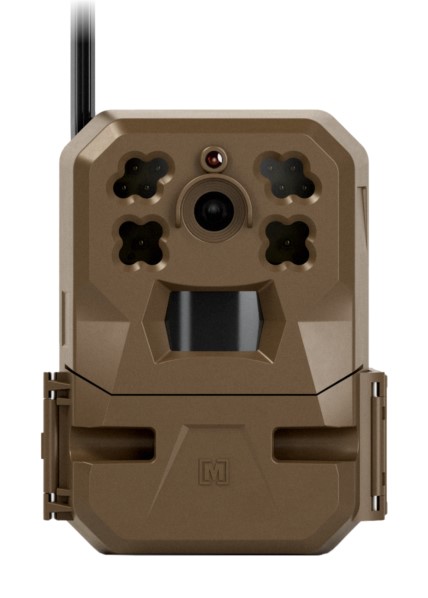
Launched Summer 2022
Late last year I was struck with inspiration for a new trail camera survey, and I wanted to strike while the iron was hot. Cellular trail cameras would be perfect for the project I had in mind, but there was one small problem–all of my existing cellular units were already in the field, working in good productive sets. I needed to get my hands on a couple of new cameras!
Tactacam’s Reveal XB has been my go-to cellular trail camera model for some time now. I have been getting good results from my Reveal XBs for well over a year, and when I decided it was time to expand my collection of cellulars, my first impulse was to head out to Amazon and and order a few more. But as I browsed through Amazon’s trail camera listings, a new model from Moultrie caught my eye–the Moultrie Mobile Edge. I was cautiously intrigued.
I say “cautiously” because I had owned an earlier model of Moultrie cellular trail camera and the experience had been more than a little disappointing. That Moultrie camera had a set of serious design flaws which left it useable only in the most controlled of circumstances. Even then the camera’s settings had to be regularly adjusted in order to better cope with varying lighting conditions that came with weather and season changes. My experience with that product made me hesitant to take another chance on Moultrie cellular cameras.
But the Moultrie Mobile Edge had an affordable price point that kept drawing me back for another look ($100 suggested, $80 retail). At that price it would be a real bargain—if it worked as advertised. As I continued my research, I noticed that the Edge claimed a few unique and intriguing features that no other camera I know of has (more about those later). I kept digging, and it was the generally strong reviews on Amazon that finally convinced me to give the Moultrie Mobile Edge a try.
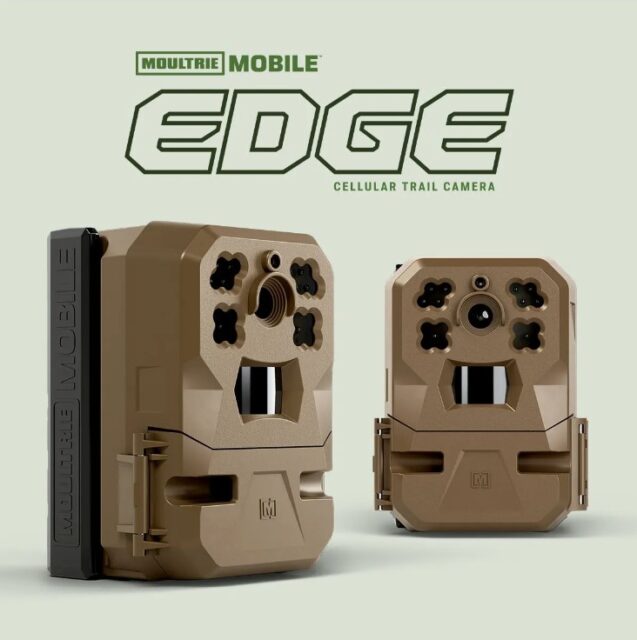
Standard Disclaimer
Before we go any further, it is important to note that I use trail cameras in what can be considered an atypical manner. I do not ordinarily use trail cameras to keep tabs on game animals, but instead employ them in pursuit of an activity know as “camera trapping.” Typically, my main goal is to record unusual and hard to observe animals and their unique behaviors. The critters I pursue can be large or small, and as varied as reptiles, mammals, and birds. I’ve even recorded spawning carp on an occasion or two–unquestionably atypical use. And as a consequence, I have a very specific set of criteria that I am looking for in a trail camera. Please keep that in mind while you read this review. My requirements may not overlap well with those seeking to use the camera to monitor game animal activity in a more conventional manner.

It’s also worth mentioning that there are a few basic things that any trail camera should be expected to do well. All trail cameras need to be able to detect the motion of an animal in their immediate field of view, and to respond fast enough to snap photographs while said animal is still in front of the camera. Trail cameras need to be durable and weatherproof. They need to facilitate mounting and securing.
It’s in the implementation details where there is room for personal preference. I have a few things that I look for in trail cameras over and above their basic functionality. Here is my short list…
- The camera can be locked up securely with a padlock so that the SD card and settings cannot be tampered with
- Minimum number of nooks and crannies for spiders and bugs to nest in
- Settings available for good close up performance
- Option not to display logo chyron
- Tripod Mount—bottom preferred. A mount located on the back of the unit is better than nothing
- Long battery life
- Minimal false triggers
Concerning Technical Support… I never have high expectations for trail camera technical support–regardless of the brand. And I’m rarely in the mood for extended hold times just to get the technical support run around. Maybe I’m being a little cynical in this regard, but my philosophy has been that a trail camera does not need to be overly complex. If it is not relatively easy to configure and setup, and/or if there are technical difficulties that prevent its use, then the camera goes back in the box and is returned to the seller for a refund. I haven’t had to do this very often, but for these reasons I do not consider technical support in my reviews.
I also do not include a full set of camera specifications in these reviews. The reader should visit the manufacturer’s website for the most current specification information in order to be sure that camera in question will meet their needs.
Finally, like most cellular trail cameras, the Moultrie Mobile Edge and its support apps offer far too many features to cover them all in detail. Instead, I’m going to touch on the subset of features that are the most relevant to the way I use the camera–hopefully they will be important to you as well. Moreover, there are differences between the functionality provided by the web app vs the phone app version of the camera manager interface. For instance, the web interface does not have an indicator to communicate that a hi-res photo has been requested, but the phone app does. I’m not going to try to discover all of these differences. Just know that for any given feature, you make have to switch form the phone app to the web app–or vice versa–to access its functionality.
The Review
Ok, now that the disclaimers out of the way, let’s get on with the review…
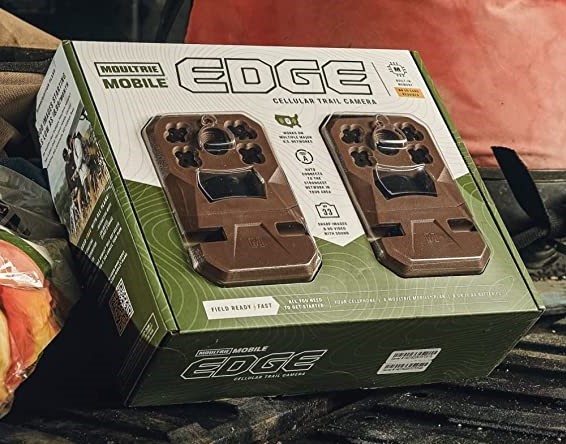
Amazon (and many other retailers) offer the Moultrie Mobile Edge either singly ($80) or as a two-pack ($150). For me, the two-pack was the right option, so that is what I ordered. And in usual fashion, Amazon had the shipment to my front door in just a few days. The cameras came packaged as shown in the picture to the right. Refreshingly, there was very little in the box: two cameras, two straps, a quick start guide, and a Moultrie logo sticker. That’s it.
The Moultrie Mobile Edge has a nice tidy design. It is compact and solid. It has two tripod mounts–one on the back and one on the bottom. The antenna is permanently attached to the camera, and cannot be readily removed, eliminating the worry that the antenna will loosen or be lost. The flip side of that coin is that there is unlikely to be a remedy if the antenna is somehow broken off. Fortunately, the antenna folds down into a neat receptacle that will help keep it safe from damage while the camera is in transport.
Setting up the cameras was a breeze. There is a QR code in the quick start guide that will help you find the app you need for your phone, and there are QR codes on the individual cameras that help you activate them in the app. The camera uses AA batteries–either lithium or alkaline–and will function with the option of 8 or 16 batteries (16 batteries are said to last longer than 8). The control panel on the trail camera is about as minimalist as I’ve ever encountered. There is an on-off switch, a connect button, and a few status LEDs… that’s it. Most of the important camera configuration is done in the app or in the online web portal. I had both of my new cameras up and running–and sending test photos–in just a matter of minutes.
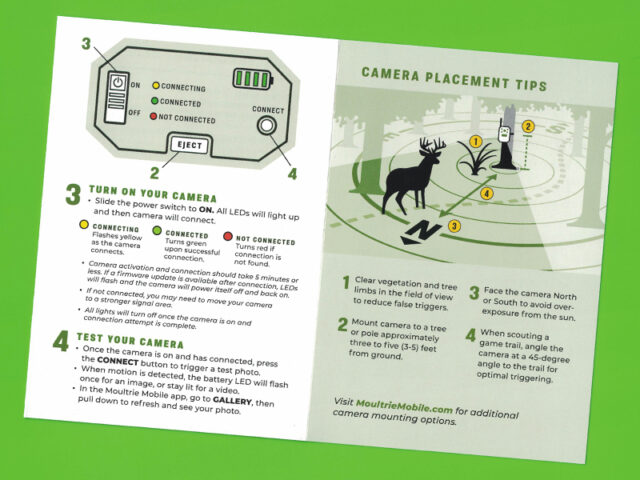
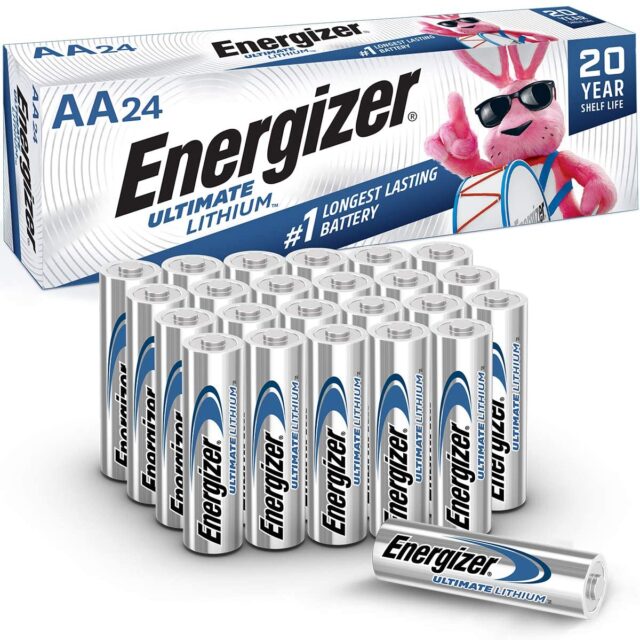
can last six months or longer in
a trail camera application.
Unfortunately, the price of these
types of batteries has gone
through the roof of late
I loaded my cameras with high quality and long lived Energizer Ultimate Lithium batteries, and right away I noticed concerning issue. According to the app interface, my brand new lithium batteries were reporting only 70% lifetime remaining. It was not immediately clear if this was a fluke caused by bad batteries, a real issue with the camera, or something else. Over time the reading went up to 80% lifetime, and then by the end of the second week of operation it was at 100%. A confusing set of readings to be sure, and one that did not do much to inspire confidence in this metric.
Nonetheless, after a few months of use I can report that the 100% reading has held steady, and battery life has proven to be excellent. This is something I am very happy about, as short battery life negates the benefit of having a cellular camera to a large degree. If you are forced to go out into the field regularly to change out batteries, there’s really very little point to the added expense of a cellular camera. Plus, batteries can be expensive—especially quality lithiums. Long battery life is simply essential for a good quality trail camera.
I’m also excited to report that false triggers have not been an issue either. False triggers are the bane of trail camera aficionados everywhere, and some cameras just do not manage this problem well. Fortunately, false triggers are not a problem with the Moultrie Mobile Edge. Fewer false triggers allows you to spend much less time actively managing the camera’s settings, and it helps you to get the most bang for you buck from the cellular service plan you select. You’re paying for pictures of wildlife, not wind induced shadow movement. I’ll say it again, the Moultrie Mobile Edge very seldom false triggers.
Cellular service with the Moultrie Mobile Edge has been general satisfactory in my experience. Moultrie offers a number of different service plan levels, and all are competitively priced. In general, plans are structured so that you a pay little more depending on the number of pictures you expect your camera to upload on a monthly basis. A little guesswork is required when purchasing your plan, but if you do happen to run out of plan credit, you can purchase more as needed to help you make it to the end of the month. Plans are offered at a slight discount if purchased at the annual rate.
The Moultrie Mobile Edge‘s picture quality is good, but not quite to the level I’d prefer. Images can contain blur and other imaging artifacts that should not be present on a good quality 33 megapixel image. The pictures produced by this unit are typical of those produced by most cellular trail cameras though, and are more than adequate for camera trapping. You just won’t be generating many high quality prints from your Moultrie Mobile Edge photos.
In the Moultrie app you are able to view low-res thumbnails (0.3MP 640 x 360) of the photographs your camera uploads–either on your phone or on the web. You can also request Hi-Res pictures for a small additional cost against your data plan’s picture allowance, and you can choose between High (4MP, native) and Enhanced (33MP 7648 x 4320) resolution options in the Moultrie Mobile app. Fortunately, you are able to turn off the info bar chyron that is superimposed across the bottom of the pictures the camera records, if that is your preference.
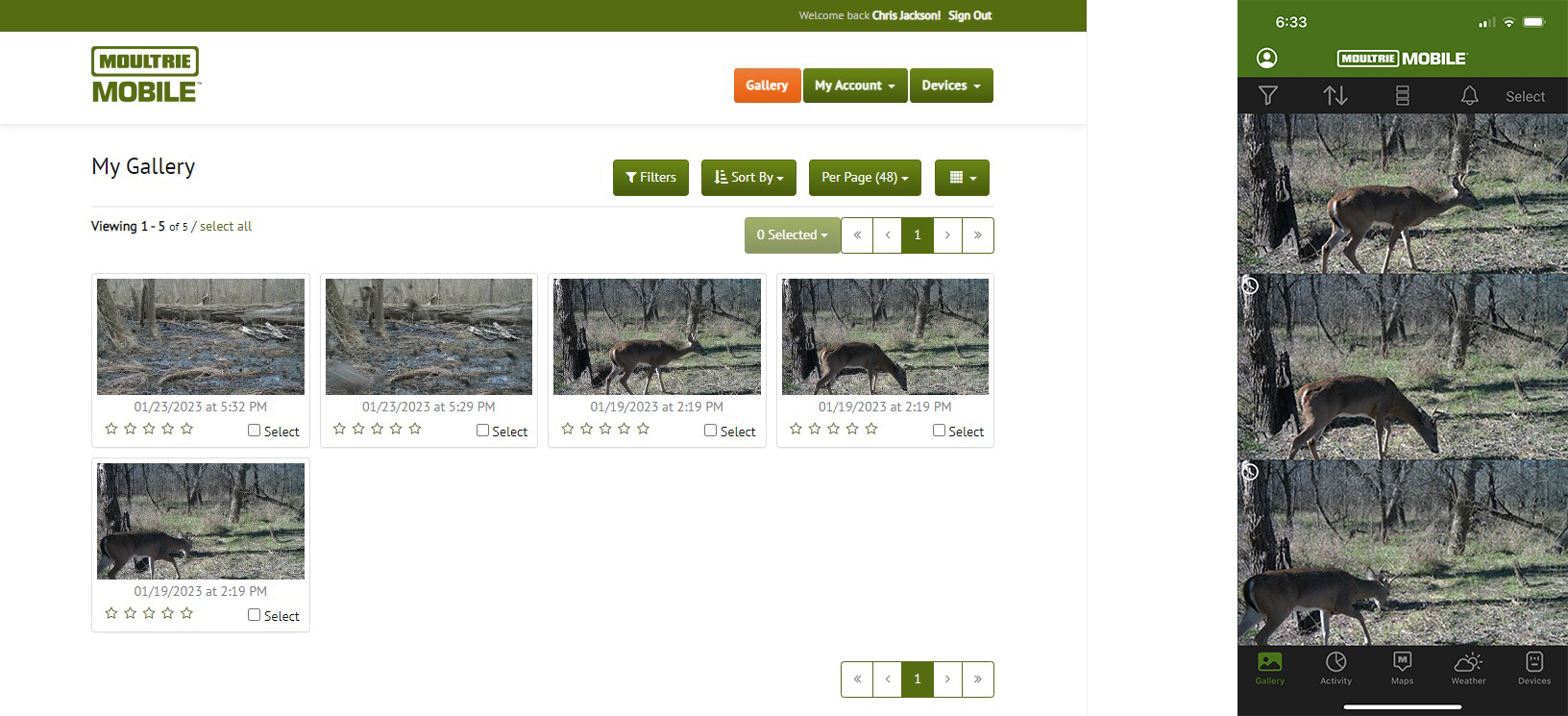
The apps are slightly out of date with regards to newer camera features.
Click to Enlarge

Actual Size

Click to Enlarge
Moultrie’s picture management scheme for the Edge is fairly typical. When the Edge records a picture it will store the hi-res photo in its internal memory as long as space is available. Once internal storage approaches maximum capacity, the camera will begin deleting the oldest pictures to free up space for new ones. Meanwhile, a thumbnail version of the picture is uploaded to Moultrie’s servers where you can view and download it using the Moultrie app or website. And if you have a picture you’re particularly interested in, you can request a hi-res version (either 4 MP or 33 MP depending on how your camera is configured) be uploaded to the server. If the hi-res picture is everything you hoped it would be, then you can then download it to your own device or computer. The catch–as I noted earlier–is that uploading hi-res images cost more against your data plan picture allowance than the thumbnails do (one hi-res image equals five thumbnails).



As I mentioned previously, I often use trail cameras to record pictures of small animals. In this pursuit I sometimes place the camera very near where I expect the subject to be when the camera is triggered. Used in this manner the Moultrie Mobile Edge has performed quite nicely, and I have been generally satisfied.

After dark, the LED flash has proven to be adequate in all of the contexts that I have tested it in. Nighttime images can be good if the subject is stationary, but the tiniest bit of movement will introduce motion blur. Regardless, the infrared images typically allow for the identification of the pictured animals, and that is really all that I require from photos taken during the darkness of night.

The Moultrie Mobile Edge also allows you to record and upload video remotely–with some limitations. Videos are recorded at 720P and are always 15 seconds in length. There is no way to adjust these settings, except to turn them off an on. When a video is recorded, a still image is uploaded to the server to serve as a thumbnail. This low-res image can be downloaded locally. If you would like to view and/or download the actual video it must be requested for upload to the server. The upload will occur at the next camera checkin, so you may have to wait some time before the video become available.
For my purposes the video quality produced by this camera is respectable–especially for a cellular trail camera. There are many models of non-cellular trail cameras that can do slightly better, but when considered along with all of the other pluses that come with using a cellular camera, I am more than satisfied with the Moultrie Mobile Edge’s video quality and its configuration limitations.
So, now that we’ve discussed the good, let’s take a look at the not-so-good aspects of this trail camera. Some of the things we will touch on going forward can be considered major issues and others are just minor annoyances. For many of you, your own personal preferences will determine which are which.
I only have a few, relatively trivial, complaints about the camera’s design. While this camera does have a generally clean execution, there are still too many arbitrary nooks and crannies for insects and spiders to exploit. It would be nice not to have to clean spider webs and insect eggs off of the camera after every use.
The Moultrie Mobile Edge is designed to facilitate the use of a cable lock system in order to prevent theft, but I am not a big fan of this method. Cable locks are too heavy and too unwieldy for my tastes. I prefer to secure my trail cameras using lightweight chains and small padlocks–just enough security to keep honest folks honest.
Unfortunately, the camera’s design does not facilitate the attachment of a padlock, and that is my most notable issue with the Moultrie Mobile Edge… There is no way to pad lock the control panel on the camera. I consider this a problem because it leaves the control panel vulnerable to both mischievous human and animals. Raccoons would have little trouble popping the unsecured latch on this camera. A person could easily switch the unit off if they wanted to–and I suppose a Raccoon could too if it really became intrigued with fiddling with the camera.
New and Unique Features
Now it’s time to address the new and unique features this camera offers. You may have noticed that I did not mention the need to install a service provider sim card during setup, nor did I describe inserting a memory card. That’s because neither are used in the Moultrie Mobile Edge. Instead of having to choose a service provider (typically AT& T or Verizon with other cameras), the Edge has the ability to select from multiple different service providers. The camera will automatically connect to the provider that has the strongest signal at the set location. In theory this seems like a great feature–one I am very excited about having–and it seems to work well as far as I can tell.
I was a little more apprehensive about the idea of giving up the use of removable SD cards on my trail cameras. Instead of supporting external memory cards, the Edge uses internal memory only (16MB). There’s no removable memory, and there is no USB port. The only way to access the pictures the camera records is online through the Moultrie app or website.

As a side note, it’s also worth mentioning that the folks at Moultrie say they will keep your cloud based picture collection available in perpetuity–even if you cancel your data plan subscription and stop using your Moultrie Mobile Edge cameras. That’s a mighty big promise.
Still, this unconventional approach to memory management caused me some concerns at first, but in the end I decided that it was worth giving it a try–and that it may even be for the best. Here’s why… As it is now I have a large collection of trail camera pictures that I have to archive. Almost every picture I have recorded with a trail camera over the last 15 years is stored away and taking up disk space on my external RAID system. The vast majority of these pictures are unremarkable, but I am a hoarder, and I have hung onto them all in the off chance I might find something useful on one at some point in the future. With the Moultrie Mobile Edge system I will be forced to do better; only a select few photographs will be worth the effort to request and download the hi-res version. I will have to be much more choosey about the images I keep.
This strategy will absolutely force me to be more economically about what pictures I choose to download and archive. In terms of making the most of the archival storage I have, being more selective about which pictures I hold on to really is a case of less being more. And while I do believe this enforced discipline will generally be for the best, there is some potential for downside. For instance, If you do not request a hi-res photo before it is deleted to make more space, then there is no way to ever have accesses to more than just the online thumbnail after the fact. The same is true if the request for a hi-res image fails for some reason. If the hi-res image does not upload, there simply is no recourse. It’s not hard to imagine a scenario where that eventuality would be heartbreaking. It is my hope that both of these possible outcomes are outliers and rare.
My testing showed that when a camera is installed in a location where the signal not the strongest, there may be problems uploading hi-res photographs. In particular, it was the color imagines that did not alway upload to the server successfully–certainly because of their larger size. Black and white imagines were not a problem. Again, the problem here is that if a hi-res image does not upload to the server, there is simply no other way to get access to that file.
There is a possibility that the camera will upload its backlog of undelivered photos if it is moved to a location where the signal strength is nice and strong, but I did not have an opportunity to put that question to the test. As it appears now, there is the risk that hi-res photos that do not upload may be lost forever. How big of a deal that is will depend much upon how and why you use your trail camera. People who buy these cameras to scout game animals might be ok with this shortcoming. Folks who are trying to record high quality images for their portfolios or for research may be less inclined to tolerate this problem.
Now let’s take a look at the final ratings taking all of the above into consideration…
- Recommend – I would recommend this camera, with the caveat to carefully consider its industry unique features (in particular the absence of removable memory). SCORE: FULL STAR
- Buy Again – I own four of these cameras now, and would consider buying more if needed. SCORE: FULL STAR
- Picture quality – Picture quality is not exceptional, but more than adequate. SCORE: FULL STAR
- Video quality – Video quality is respectable for a cellular trail camera. SCORE: FULL STAR
- False triggers – False triggers are few and far between. SCORE: FULL STAR
- Battery Life – Battery life has been exceptional. SCORE: FULL STAR
- Affordable – At around $90 a piece—$150 for the two-pack—these units are a solid bargain. Cellular service plan pricing is competitive SCORE: FULL STAR
- Cellular Reception – Cellular reception has not been an issue. SCORE: FULL STAR
- Phone and Web Apps – Both apps could be better, and there are a few minor inconsistencies between the two. But despite their shortcomings, they get the job done. SCORE: HALF STAR
- Special Considerations – Two issues: I’m not a big fan of external antennas on cellular trail cameras, and there is no way to secure the control panel with a pad lock. The new and unique features of no service provider sim card, and no external memory are pluses in my book, but do come with some risk. SCORE: HALF STAR
RATING: Nine out of Ten Stars

The Moultrie Mobile Edge is a pretty good trail camera. And even while I remain on the lookout for the perfect cellular trail camera–for the time being–the Moultrie Mobile Edge suits me just fine. I paid right around $75 a piece for my Moultrie Mobile Edges. These are some of the least expensive cellular models that I have ever purchased. Most of the other cellulars in my collection have cost two to three times as much. None of those have been perfect. Some have been pretty good. Others have been complete disasters. The Moultrie Mobile Edge comes with its own set of unique pros and cons, and as such is as good or better than any cellular trail camera I’ve owned to date. They are definitely worth taking a chance on.
Addendum
For those of you who are a little more forward looking, it might be worth your while to make note of the new and upcoming Moultrie Mobile Edge PRO due to hit the market in the summer of 2023. This latest addition to the Edge product line promises to come with some really exciting new features. The one I am most keen on is something Moultrie calls False Trigger Elimination (FTE) technology. Here’s how FTE is described on the Moultrie webpage…
FTE eliminates false triggering by up to 99% and can correctly identify the species you’re targeting with up to 96% accuracy. This means if deer photos are what you want, deer photos are what you get.
Moultrie

with False Trigger Elimination (FTE).
Coming summer 2023
The details of how FTE works are not expounded on in the promotional materials, but I suspect it uses AI to delete images that do not contain the animals you are interested in photographing. If you tell the camera you only want pictures of deer, then the AI will review each picture taken and discard the ones that do not include deer. That means any false triggers will be tossed, as well as any incidental pictures taken of Coyotes, Raccoons, Squirrels, birds, butterflies, et al. FTE is a feature that has been on my wish list for over ten years now, and if it works as promised, it will be a real game-changer.
Moultrie also promises to include Live Aim with this model. This technology will allow you to connect your phone to your camera via Bluetooth so that you can see what your camera sees. This new feature will be invaluable when framing your shots–a real time saver. You will have the ability to be sure the framing you want is the framing you will get before ever walking away from the camera.
With these two new features plus a whole host of other refinements and improvements, the Moultrie Mobile Edge PRO promises to be a trail camera worth trying out. Keep an eye out for it arriving in the stores sometime around midyear!


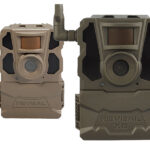
Can’t wait for the pro
I have been well pleased with my Moultrie Edge and will probably purchase the new Pro model
Just put up my new edge cameras and so far I’m not happy using way too many batteries. It took 65 pictures and killed a 12 V external battery pack for moultrie. So I installed a brand new set of Moultrie batteries. And they are dying. Also ! I am not happy so far.
Received 300 pictures the first week in an area without amazing reception. Camera strength weak to fair. Have gotten 8 pictures in week two with better reception overall than week one. ♂️ No options for replacement antenna or booster. Not sure what I’ll do with this as you have to pay up front for best deal on plans. Well played MoultrieMobile! Great camera and features if it works in your area. Gotta buy one to find out!
Camera trigger speed does not meet expectations and/or motion detection sucks.